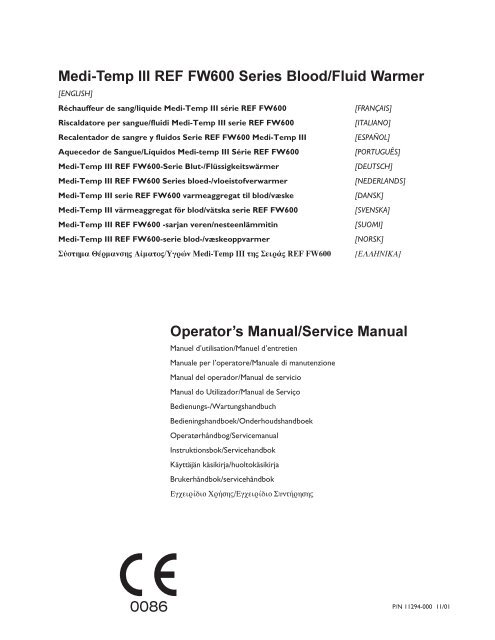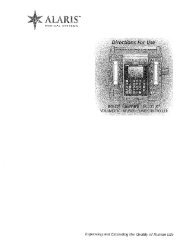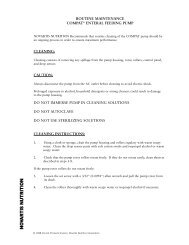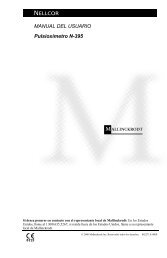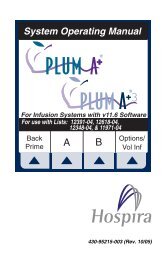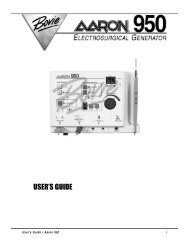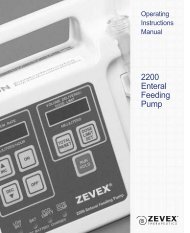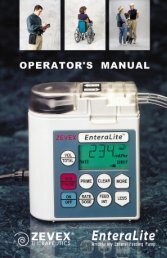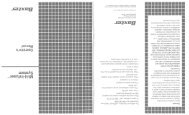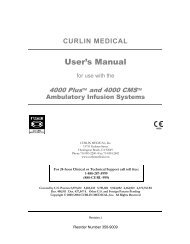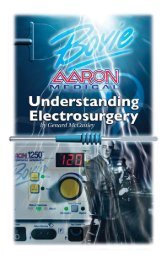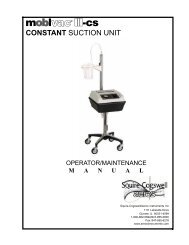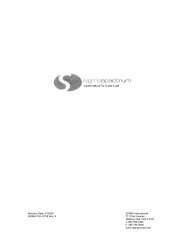Gaymar FW600 Operator's Manual
Gaymar FW600 Operator's Manual
Gaymar FW600 Operator's Manual
You also want an ePaper? Increase the reach of your titles
YUMPU automatically turns print PDFs into web optimized ePapers that Google loves.
Medi-Temp III REF <strong>FW600</strong> Series Blood/Fluid Warmer<br />
[ENGLISH]<br />
Réchauffeur de sang/liquide Medi-Temp III série REF <strong>FW600</strong><br />
[FRANÇAIS]<br />
Riscaldatore per sangue/fluidi Medi-Temp III serie REF <strong>FW600</strong><br />
[ITALIANO]<br />
Recalentador de sangre y fluidos Serie REF <strong>FW600</strong> Medi-Temp III<br />
[ESPAÑOL]<br />
Aquecedor de Sangue/Líquidos Medi-temp III Série REF <strong>FW600</strong><br />
[PORTUGUÊS]<br />
Medi-Temp III REF <strong>FW600</strong>-Serie Blut-/Flüssigkeitswärmer<br />
[DEUTSCH]<br />
Medi-Temp III REF <strong>FW600</strong> Series bloed-/vloeistofverwarmer<br />
[NEDERLANDS]<br />
Medi-Temp III serie REF <strong>FW600</strong> varmeaggregat til blod/væske<br />
[DANSK]<br />
Medi-Temp III värmeaggregat för blod/vätska serie REF <strong>FW600</strong><br />
[SVENSKA]<br />
Medi-Temp III REF <strong>FW600</strong> -sarjan veren/nesteenlämmitin<br />
[SUOMI]<br />
Medi-Temp III REF <strong>FW600</strong>-serie blod-/væskeoppvarmer<br />
[NORSK]<br />
Óýóôçìá ÈÝñìáíóçò Áßìáôïò/Õãñþí Medi-Temp III ôçò ÓåéñÜò REF <strong>FW600</strong> [ÅËËÇÍÉÊÁ]<br />
Operator’s <strong>Manual</strong>/Service <strong>Manual</strong><br />
Manuel d’utilisation/Manuel d’entretien<br />
<strong>Manual</strong>e per l’operatore/<strong>Manual</strong>e di manutenzione<br />
<strong>Manual</strong> del operador/<strong>Manual</strong> de servicio<br />
<strong>Manual</strong> do Utilizador/<strong>Manual</strong> de Serviço<br />
Bedienungs-/Wartungshandbuch<br />
Bedieningshandboek/Onderhoudshandboek<br />
Operatørhåndbog/Servicemanual<br />
Instruktionsbok/Servicehandbok<br />
Käyttäjän käsikirja/huoltokäsikirja<br />
Brukerhåndbok/servicehåndbok<br />
Åã÷åéñßäéï ×ñÞóçò/Åã÷åéñßäéï ÓõíôÞñçóçò<br />
P/N 11294-000 11/01
ENGLISH<br />
Table of Contents<br />
Sec Topic Page<br />
1.0 Indications for Use ........................................ 1<br />
2.0 Product Description ..................................... 2<br />
3.0 Instructions for Use ...................................... 4<br />
4.0 Safety Systems ................................................ 7<br />
5.0 Cleaning ........................................................... 7<br />
6.0 Functional Check/Safety Inspection .......... 8<br />
7.0 Troubleshooting ..........................................10<br />
8.0 Technical Specifications..............................11<br />
Before you begin . . .<br />
Important<br />
Before using the Medi-Temp III <strong>FW600</strong> Series Blood/<br />
Fluid Warmer, please read and understand this<br />
Operator’s <strong>Manual</strong> and the SAFETY PRECAUTIONS prior<br />
to use.<br />
If you have any questions, please contact your local<br />
dealer for assistance.<br />
Warranty<br />
The Medi-Temp III <strong>FW600</strong> Series Blood/Fluid Warmer<br />
is warranted free of defects in material and<br />
workmanship for a period of one (1) year.<br />
The Disposable Warming Sets are warranted free of<br />
defects in material and workmanship for a single<br />
application.<br />
A copy of the warranty is available upon request.<br />
<strong>Gaymar</strong> disclaims all implied warranties including, but<br />
not limited to, the implied warranties of<br />
merchantability and of fitness for a particular purpose.
ENGLISH<br />
1.0 Indications for Use<br />
This device is intended to aid in the prevention of<br />
inadvertent hypothermia during administration of<br />
blood, blood products, and other fluids.<br />
1.1 Safety Precautions<br />
DANGER<br />
Risk of electric shock.<br />
No user serviceable parts inside.<br />
WARNING<br />
• All air must be removed from the fluid lines<br />
prior to connection to the patient.<br />
• Monitor the fluid lines to insure they are air<br />
free. Never administer fluids if there are air<br />
bubbles in the line between the bubble trap<br />
and the patient connector.<br />
• Monitor the fluid level in the bubble trap<br />
frequently. Bubbles released during heating<br />
are captured in the trap. To refill the trap,<br />
insert a sterile syringe into the valve and draw<br />
air out until the trap is (2/3) full. Do not allow<br />
the bubble trap to go below one-quarter<br />
(1/4) full.<br />
• The bubble trap must be kept mounted and<br />
in the vertical position at all times.<br />
Failure to follow the above warnings<br />
could result in the introduction of air to<br />
the patient. Introduction of air to the<br />
patient could result in death or serious<br />
injury.<br />
CAUTION<br />
• US Federal law restricts this device to sale by<br />
or on the order of a physician.<br />
• Do not immerse in cleaning and/or<br />
sterilization solution. Do not submerge or<br />
soak unit; it is fluid resistant, not fluid proof.<br />
• For grounding reliability of the Blood/Fluid<br />
warmer, plug only into a properly grounded<br />
outlet.<br />
• The RUN/STANDBY switch does not provide<br />
isolation from the mains. Isolation from the<br />
mains (IEC 601-1) can only be achieved by<br />
disconnecting the cord from the mains.<br />
1
ENGLISH<br />
REMOVE FROM USE<br />
indicator<br />
STANDBY<br />
indicator<br />
SETPOINT switch<br />
button<br />
IV pole clamp<br />
RUN /STANDBY<br />
switch<br />
Cassette slot<br />
Bubble trap<br />
receiver<br />
Figure 1—<strong>FW600</strong> series Blood/Fluid Warmer<br />
2.0 Product Description<br />
The Medi-Temp III <strong>FW600</strong> Series Blood/Fluid Warmer<br />
is a dry-heat device designed for safe and rapid<br />
warming of blood, blood products and other fluids<br />
through the utilization of disposable blood/fluid<br />
warming sets. The warmer does not provide fluid flow<br />
rate control. Blood, blood products and other fluids<br />
normally refrigerated, can be rapidly warmed to user<br />
selectable temperatures of between 38.0°C–43.0°C<br />
at flow rates up to 300 ml/min. Room temperature<br />
fluids can be warmed at flow rates up to 500 ml/min.<br />
The disposable Blood/Fluid warming sets are available<br />
in Standard, Standard with Extensions, Pediatric, and<br />
High Flow models.<br />
2.1 Warmer<br />
The warming unit is designed to be IV pole<br />
mounted. The device has no on/off switch.<br />
Connection to the AC supply is indicated by a<br />
green STANDBY mode indicator, located on the<br />
front panel. In STANDBY mode, no power can be<br />
applied to the heater. To begin normal operation,<br />
the RUN/STANDBY button must be pressed.<br />
When this occurs, an LED temperature display located<br />
on the front panel will display the actual fluid<br />
temperature or the setpoint temperature in °C.<br />
The setpoint is user selectable from 38.0°C–43.0°C<br />
in 1.0°C increments, by use of the SETPOINT switch on<br />
the front panel. Also located on the front of the unit is<br />
a slot for insertion of the disposable warming set. On<br />
the right side of the unit, just below the IV pole clamp,<br />
is a receiver for the disposable warming set’s bubble<br />
trap.<br />
2.2 Disposable sets<br />
The Medi-Temp III <strong>FW600</strong> Series Blood/Fluid warming<br />
unit is designed to be used only with <strong>Gaymar</strong> D25000<br />
series disposable warming sets. The following warming<br />
sets (figure 2) are designed for use up to 300 mm Hg<br />
pressure. Contact your local dealer for more<br />
information.<br />
2
ENGLISH<br />
Description<br />
Catalog<br />
Number<br />
Application<br />
Priming<br />
Volume<br />
Standard<br />
D25340CE<br />
KVO—150<br />
ml/min<br />
39 ml<br />
Standard<br />
with 48" extension<br />
D25310CE<br />
KVO—150<br />
ml/min<br />
48 ml<br />
Standard<br />
with 60" extension<br />
D25315CE<br />
KVO—150<br />
ml/min<br />
50 ml<br />
Pediatric<br />
with 30" extension<br />
D25320CE<br />
KVO—100<br />
ml/min<br />
30 ml<br />
High<br />
Flow with 48" extension<br />
D25330CE<br />
100—500<br />
ml/min<br />
79 ml<br />
KVO = minimum flow required to keep veins open<br />
Figure 2—D25000 series warming sets<br />
G<br />
A<br />
A<br />
Flexible Cassette<br />
D<br />
B<br />
B<br />
<strong>Manual</strong> Air Eliminator<br />
(Relief Valve)<br />
C<br />
C<br />
Bubble Tra p<br />
F<br />
D<br />
Clamp<br />
D<br />
E Male Luer (to Patient)<br />
E<br />
F<br />
G<br />
Female Luer<br />
(to Blood/Fluid Source)<br />
Blue Guide Rail<br />
Figure 3—Warming set and bubble trap<br />
3
ENGLISH<br />
3.0 Instructions for Use<br />
(see figures 3—5)<br />
• Attach warming unit to IV pole and secure<br />
with clamp on side of unit.<br />
• Plug the power cord into a properly<br />
grounded outlet.<br />
• Remove the warming set from it’s sterile<br />
packaging<br />
NOTE: The flexible warming set is designed so<br />
it can be inserted into the warmer in only one<br />
orientation. Orient the cassette so that the blue<br />
guide rail is inserted into the bottom of the<br />
warming unit.<br />
ΠGrasp each rail (see figure 4). Stretch the flexible<br />
cassette slightly and insert the front end of the<br />
cassette into the front of the warming unit, with<br />
the blue guide rail facing down. Align the rails to<br />
each of the slotted openings.<br />
Figure 4—Inserting the cassette<br />
Move hands to the rail protrusions and continue<br />
to insert the cassette until the clear guide rail is<br />
almost flush with the front of the unit. (The blue<br />
guide rail will protrude slightly for easy removal.)<br />
Figure 5—Setup instructions<br />
4
ENGLISH<br />
CAUTION<br />
When fully inserted, the clear guide rail<br />
should protrude no more than 0.5 cm from<br />
the front of the warming unit. Failure to<br />
fully insert the cassette may result in<br />
damage to the cassette.<br />
Close warming set input clamp. Remove the<br />
protector from the female luer of the warming set<br />
and connect it to the male luer on the IV<br />
administration set. Remove the protector from<br />
the male luer of the warming set. To minimize<br />
temperature drop and priming volume, remove<br />
unnecessary lead extensions at this time.<br />
Ž Invert the bubble trap.<br />
Open warming set input clamp. Allow fluid to<br />
prime the set. When the bubble trap fills to<br />
approximately (2/3) full, close the output clamp.<br />
Re-invert the bubble trap and place it into the<br />
bubble trap receiver on the side of the warming<br />
unit.<br />
WARNING<br />
The bubble trap must be mounted and kept in<br />
a vertical position at all times. Failure to do<br />
so could result in the introduction of air<br />
to the patient, resulting in death or<br />
serious injury.<br />
NOTE: holding down the SETPOINT switch<br />
indefinitely will not increment the setpoint.<br />
After the selection has been made, the display will<br />
continue to flash this setpoint for approximately<br />
3 seconds, then revert to displaying the actual fluid<br />
temperature. The setpoint can be checked at any<br />
time during the procedure by momentarily<br />
pressing the SETPOINT switch.<br />
’ If required, connect an extension for patient<br />
connection.<br />
“ Purge air from remaining length of tubing by<br />
opening output clamp and allowing fluid to flow.<br />
WARNING<br />
• All air must be removed from the fluid lines<br />
prior to connecting to the patient.<br />
• Monitor the fluid lines to ensure they are air<br />
free. Never administer fluids if there are air<br />
bubbles in the line between the bubble trap<br />
and the patient connector.<br />
Failure to do so could result in the<br />
introduction of air to the patient,<br />
resulting in death or serious injury.<br />
WARNING<br />
‘ Press the RUN/STANDBY switch on the<br />
front of the unit.<br />
Upon successful completion of self-diagnostics,<br />
the display will flash the setpoint for approximately<br />
3 seconds, then begin warming the fluid to the<br />
selected temperature.<br />
The setpoint most recently used is retained<br />
in memory, even after power is removed.<br />
To select an alternate setpoint, first press the<br />
SETPOINT switch<br />
momentarily.<br />
This will cause the setpoint to be displayed and<br />
flash for approximately 3 seconds. While the<br />
display is flashing the setpoint, the user may select<br />
any setpoint between 38.0°C and 43.0°C in 1.0°C<br />
increments by repeatedly pressing the SETPOINT<br />
switch.<br />
Monitor the fluid level in the bubble trap<br />
frequently. Bubbles released during heating<br />
are captured in the trap. To refill the trap,<br />
insert a sterile syringe into the valve and draw<br />
air out until the trap is two-thirds (2/3) full.<br />
Do not allow the bubble trap to go below<br />
one-quarter (1/4) full.<br />
Failure to monitor the fluid level in the<br />
bubble trap could result in the<br />
introduction of air to the patient,<br />
resulting in death or serious injury.<br />
5
ENGLISH<br />
Temperature at the End of Patient Line<br />
Setpoint 43.0°C Ambient 22°C<br />
45<br />
40<br />
Temperature °C<br />
35<br />
30<br />
25<br />
"High Flow w/48"extension,<br />
20° input fluid"<br />
"Standard w/48"extension,<br />
10° input fluid"<br />
20<br />
0 50 100 150 200 250 300 350 400 450 500 550 600<br />
Flow in ml/min<br />
Figure 6—Typical fluid temperature vs. flow rate<br />
3.1 Effect of Flow Rate on Fluid<br />
Temperature<br />
Fluid temperatures exiting the patient line are affected<br />
by flow rate. The following flow vs. output fluid<br />
temperature curve is typical for the <strong>FW600</strong> series<br />
warming unit. See figure 6 above.<br />
NOTE: Output fluid temperature for this curve is<br />
measured at the end of the patient line.<br />
3.2 Warming Set Removal<br />
The cassette cannot be removed from the warming<br />
unit while under pressure. To remove the cassette:<br />
1. Close the warming set input clamp first, while<br />
leaving the output clamp open.<br />
2. Close the warming set output clamp.<br />
3. Following steps 1 and 2 will allow fluid to drain<br />
from the cassette. Gently pull on blue guide rail to<br />
remove cassette from warming unit.<br />
4. Dispose of warming set per facility protocol.<br />
CAUTION<br />
Failure to drain cassette will make it difficult<br />
to remove. Forcing the cassette out may<br />
cause it to rupture.<br />
6
ENGLISH<br />
4.0 Safety Systems<br />
4.1 Over Temperature Protection<br />
A backup system within the warmer is independent of<br />
the main controller and monitors fluid temperature<br />
continuously. If the output fluid temperature exceeds<br />
45.0°C, the backup system will immediately interrupt<br />
power to the heaters. If the over-temperature<br />
condition is a temporary occurrence as a result of a<br />
sudden change in flow rate, the display will alternately<br />
flash HI and the fluid temperature. When the fluid<br />
temperature returns to acceptable temperature levels,<br />
normal operation will resume. If, however, the backup<br />
system detects that the over-temperature condition is<br />
a result of a failure of the main controller, an audible<br />
alarm will sound, the RFU (REMOVE FROM USE)<br />
indicator will light, and the device will shut down.<br />
If this occurs, immediately stop the fluid flow, discard<br />
the warming set, and contact your dealer for service.<br />
4.2 Self-diagnostics<br />
Each time the warming unit is switched from STANDBY<br />
mode to RUN mode, a self-test is initiated. If the<br />
backup system is not functioning properly, an error<br />
message will be displayed and the unit will shut down.<br />
In addition, self-tests are routinely performed during<br />
RUN mode to ensure continued safe operation of the<br />
warming unit.<br />
4.3 Control Alarm LO<br />
If the warming unit senses a fluid temperature less than<br />
34.0°C, the audible alarm will chime and the display<br />
will alternately indicate the symbol LO, and the actual<br />
fluid temperature.<br />
Exception: The unit will not alarm until the fluid<br />
temperature has initially surpassed the<br />
34.0°C threshold.<br />
5.0 Cleaning<br />
CAUTION<br />
Do not immerse the warmer in cleaning or<br />
disinfectant solutions. Do not submerge it in<br />
liquids; it is fluid-resistant, not fluid-proof.<br />
Immersion could result in malfunction<br />
or equipment damage.<br />
Perform the following care and cleaning between<br />
patient use or per facility protocol.<br />
• Unplug unit prior to cleaning<br />
• To clean the external surfaces of the warmer, use<br />
a non-abrasive cleaning solution (such as warm<br />
soap water) and a clean cloth.<br />
• Clean inside of cassette slot with disposable brush.<br />
Carefully flush using squeeze bottle with water.<br />
Replacement cleaning kit P/N 78350-000.<br />
• Apply a disinfectant such as 10% chlorinated<br />
bleach solution (chlorinated bleach with 5.25%<br />
sodium hypochlorite) to both the outside of the<br />
unit and the cassette slot and allow to dry.<br />
CAUTION<br />
The warming unit should be cleaned if any<br />
fluid or foreign substance has entered the<br />
cassette slot. Failure to keep the cassette<br />
slot clean could impede cassette<br />
insertion.<br />
7
ENGLISH<br />
6.0 Functional Check and Safety<br />
Inspection<br />
To assure optimum performance, dependability, and<br />
safety, the following should be performed every twelve<br />
months or as specified in the facility’s preventive<br />
maintenance program.<br />
Equipment or tools required<br />
o Any <strong>Gaymar</strong> D25340 series Blood/Fluid<br />
Warming Set<br />
o<br />
o<br />
o<br />
o<br />
Temperature measurement device:<br />
• <strong>Gaymar</strong> D25340 Blood/Fluid Warming<br />
Set; and<br />
• Temperature sensor (<strong>Gaymar</strong> catalog<br />
FWT1) and an ohmmeter (accuracy,<br />
1.5% of reading; maximum excitation<br />
current of 100uA) and the resistance<br />
temperature chart. See figure 10 (p. 12).<br />
or<br />
• Any <strong>Gaymar</strong> D25000 series<br />
Blood/Fluid Warming Set; and<br />
• Waterproof temperature sensor/<br />
meter with an accuracy of ± 0.3%<br />
across the range of 30°C to 60°C<br />
and a thermal time constant of 2<br />
seconds or faster.<br />
Flow measurement device (<strong>Gaymar</strong><br />
catalog FWT2 flowmeter):<br />
• Fluid source with calibrated flow<br />
meter and a minimum accuracy of<br />
± 12 ml/minute<br />
or<br />
• Fluid source with adjustable flow<br />
control, Use a stop watch and<br />
graduated cylinder to adjust flow<br />
rate.<br />
Current Leakage/Ground resistance tester<br />
AC multimeter<br />
6.1 Physical Inspection<br />
Check that the following items are in good condition<br />
and secure.<br />
o Labels, if peeling or missing<br />
o<br />
o<br />
Screws in cover<br />
Bubble trap receiver<br />
6.2 Output Fluid Temperature<br />
Verification<br />
The <strong>FW600</strong> Series Blood/Fluid Warmer is factory<br />
calibrated at a flow rate of 100 ml/min with a set point<br />
of 43.0°C.<br />
To verify the output fluid temperature is correct:<br />
1. The ambient room temperature must be between<br />
20°C to 24°C.<br />
2. Connect the test setup (see figure 7). Attach the<br />
<strong>Gaymar</strong> FWT1 temperature sensor to the output<br />
of the bubble trap.<br />
Alternate method: Put a hole in the top of the<br />
bubble trap and insert a temperature<br />
measurement device through this hole. Make<br />
certain sensor is completely submerged in<br />
fluid then seal the hole in the bubble trap.<br />
3. Connect the FWT2 flowmeter or flow<br />
measurement/control device to the output of the<br />
FWT1 temperature sensor.<br />
Alternate method: If using the sensor in the bubble<br />
trap method, connect the FWT2 flowmeter or<br />
flow measurement/control device directly to the<br />
output of the bubble trap.<br />
4. Flow room temperature water through the<br />
warmer at 100 ml/min (cc/min). Verify that the<br />
bubble trap is maintained 1/2 to 2/3 full.<br />
5. Turn the warmer on. Adjust the SETPOINT to<br />
43.0°C. Allow it to run for 10 minutes.<br />
6. Verify that the output water temperature is<br />
43.0°C ± 1.1°C. If using the FWT1 temperature<br />
sensor and an ohmmeter, verify that the resistance<br />
is within 1019—1112 ohms.<br />
If temperature or resistance values are not<br />
met, check setup and repeat test. If still not<br />
within range, contact your dealer for service.<br />
This device is factory calibrated and cannot be<br />
field adjusted.<br />
6.3 Overtemp Protection Verification<br />
Proper operation of the overtemp protection system is<br />
verified each time the unit is switched from STANDBY<br />
to RUN mode. Therefore, periodic testing of this<br />
system is not necessary. However, the following<br />
procedure may be used to force an OVERTEMP<br />
condition in order to observe that the overtemp<br />
protection system works:<br />
o<br />
o<br />
Power cord<br />
IV pole clamp<br />
8
ENGLISH<br />
Figure 7—Test setup<br />
1. Insert any D25000 series Warming cassette<br />
into the warming unit. Using hot tap water<br />
(46°C–50°C), flow hot water through the<br />
cassette for approximately 1-3 minutes.<br />
2. Connect AC power to the warming unit. The<br />
device should immediately sound the audible alarm<br />
and light the RFU light.<br />
6.4 Ground Resistance Check<br />
Use a current leakage/ground resistance tester to<br />
measure the resistance between the ground pin on the<br />
power plug and the mounting screw on the IV pole<br />
clamp.<br />
The resistance value should not exceed 0.50 ohms.<br />
6.5 Current Leakage Test<br />
Measure the maximum earth leakage current (ground<br />
open). Measure all combinations of line polarity with<br />
neutral open and closed. Values should not exceed the<br />
following;<br />
<strong>FW600</strong> neutral closed ...... 150µA<br />
<strong>FW600</strong> neutral open ........ 200µA<br />
FW603 neutral closed ...... 250µA<br />
FW603 neutral open ........ 300µA<br />
9
ENGLISH<br />
7.0 Troubleshooting<br />
Symptom<br />
Display alternately flashes<br />
LO and the fluid<br />
temperature<br />
Display alternately flashes<br />
HI and the fluid<br />
temperature<br />
Audible alarm sounds and<br />
display flashes LO and the<br />
fluid temperature<br />
Audible alarm sounds and<br />
display indicates FA_<br />
Audible alarm sounds<br />
continuously and yellow<br />
RFU light is lit<br />
Cassette is difficult to<br />
insert into warming unit<br />
Cassette is difficult to<br />
remove from warming unit<br />
Probable<br />
causes<br />
Output fluid temperature has<br />
not yet reached 34°C.<br />
A transient disturbance, such as<br />
a sudden change in flow rate,<br />
has caused the fluid temperature<br />
to rise above 43°C.<br />
Output fluid temperature has<br />
dropped below 34°C.<br />
The electronic diagnostics have<br />
detected an internal problem.<br />
Internal fluid temperatures have<br />
exceeded 45°C and backup<br />
system has been activated.<br />
Cassette primed prior to<br />
insertion.<br />
Inside slot of warming unit may<br />
have contamination on the<br />
heater plates.<br />
Cassette<br />
is still pressurized.<br />
Required action<br />
Allow unit to run for 2 minutes.<br />
If temperature does not increase,<br />
remove from use and request service.<br />
NONE—unit will resume normal<br />
operation when temperature drops<br />
below 43°C.<br />
Allow unit to run for 2 minutes.<br />
If temperature does not increase,<br />
remove from use and request service.<br />
Remove from use and request service.<br />
Stop fluid flow, discard<br />
request service.<br />
Drain cassette and reinsert.<br />
cassette, and<br />
Clean inside of unit by following<br />
cleaning procedure (section 5.0)<br />
Close input clamp and open<br />
clamp. Allow fluid to drain.<br />
output<br />
Figure 8—Troubleshooting chart<br />
10


